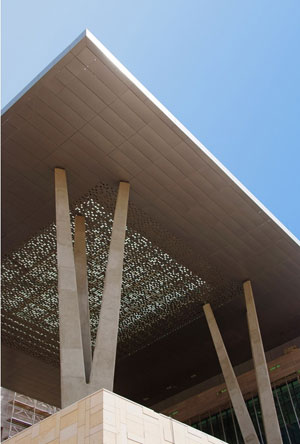Aluminum: A Sustainable Structural Choice
Reduce
Architects are utilizing aluminum over steel for clear span applications because it is lightweight, corrosion resistant, extrudable into many custom forms, can be assembled and erected on difficult sites and is a sustainable material. Aluminum can also be designed for disassembly for future use in new projects.
Lightweight aluminum structures can weigh anywhere from 35 percent to as much as 80 percent less than steel, yet provide equivalent strength. Because aluminum is extrudable, it can be designed to put the material only where it is structurally required. Custom extrusions are designed per project allowing the minimal use of the metal and reducing overall costs and raw material use. These extrusions greatly eliminate the fabrication required to create the structural shape. The overall reduced weight of the structure enables efficient assembly, reduced transportation and additional savings on construction.
Although often considered a more expensive alternative to steel, in case after case, design professionals are finding that the costs are equal or less when specifying aluminum for major structural systems. Redundant secondary framing is unnecessary with efficient geometry creation as the structural shell system. This lightweight material can be shipped as components to be assembled on site without a crane. Aluminum structures are assembled with bolted connections and there is no welding required in the field. The connections are designed to accommodate the intersection of several members facilitating the ease of joining members together.
Aluminum is also easy to shape, extrude and machine into many types of structural components. Aluminum extrusions are fabricated with dies that can increase the thickness of the members where they are needed and decrease it where it is not needed while maintaining structural integrity. “Putting the metal where it is needed is one of the great advantages of aluminum as a material. The efficient use of materials results in lower cost structures,” notes CST Cover’s Ferretti as she comments on the diverse uses of this twentieth-century structural product.
Most window extrusions for commercial properties are made from aluminum. By using custom structural aluminum framing, adding skylights, windows, sun shading and solar panels are integral to the structure. Using aluminum eliminates dissimilar expansion and contraction rates of different materials. Complex shapes can be produced in one-piece extrusions without using mechanical fasteners. One-piece extrusions are less likely to fail, leak or loosen over time and are ideal for integrated system design.
An additional savings to labor and materials is the ability of aluminum to be used with a mill finish. Aluminum naturally generates a protective oxide coating providing a finish that is durable, corrosion resistant and aesthetically pleasing. Using a mill finish can also expedite delivery. Other environmentally friendly finishes that are chosen for appearance can also be applied. Finishes vary from mill finish to highly polished finishes and include sandblasting, anodizing, specialty coatings, paints and powder coatings.











